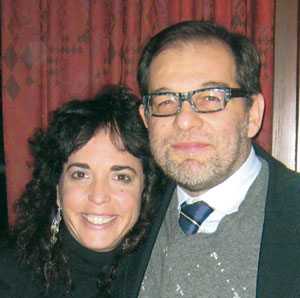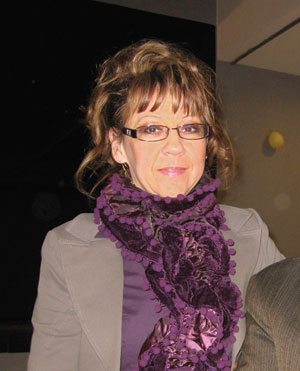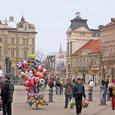.jpg) The last two weeks of 2008 I had the opportunity to meet and collaborate with flute teachers and their students in Serbia under the auspices of a Fulbright Grant. Formerly a Yugoslavian republic, today Serbia shares its borders with Hungary, Romania, Bulgaria, Albania, Monte-negro, Bosnia, and Herzegovina. The region, in general, is known as the Balkans, a cultural crossroads with Latin, Turkish, and Greek influences and a meeting point between Islam and Christianity (Orthodox and Catholic).
The last two weeks of 2008 I had the opportunity to meet and collaborate with flute teachers and their students in Serbia under the auspices of a Fulbright Grant. Formerly a Yugoslavian republic, today Serbia shares its borders with Hungary, Romania, Bulgaria, Albania, Monte-negro, Bosnia, and Herzegovina. The region, in general, is known as the Balkans, a cultural crossroads with Latin, Turkish, and Greek influences and a meeting point between Islam and Christianity (Orthodox and Catholic).
Serbian History
The history of the region is long and complex, but its more recent history is marked by communism under Josip Broz Tito, Yugoslavian ruler from 1945 to 1980, and internal strife amongst local ethnicities. The early 1990s are notable for the disintegration of Yugoslavia into separate republics, a civil war between the Croats, Serbs, and Muslims, and wartime atrocities. In 1999 the U.S. led NATO military forces in ejecting Serbian troops from the mostly Albanian-inhabited Kosovo.
In 2001 Yugoslav federal authorities arrested then President of the Federal Republic of Yugoslavia, Slobodan Milošević, who was later charged with war crimes and sent to The Hague where he died in 2006.
Serbia and Montenegro declared themselves independent countries in June of 2006, but Kosovo, which declared independence in early 2008, remains a disputed region. As recently as March 2008, the U.S. State Department had issued a travel alert for Serbia after a demonstration in Belgrade turned violent and the U.S. Embassy was heavily damaged after Kosovo declared its independence.
 Little physical evidence exists today of Serbia’s violent history. Only through conversations with locals in Serbia and Chicago (home to the largest number of Serbians outside of Serbia due to the 1990s’ diaspora) did I learn of the hardships some of them suffered as a result of the region’s political unrest. Once in Belgrade and Novi Sad, I was overwhelmed by not only the interest and talent of the students but by everyone’s warmth and hospitality. The culture was as vibrant as their odd-metered folk music, and as warm and filling as their cuisine on a cold winter’s night.
Little physical evidence exists today of Serbia’s violent history. Only through conversations with locals in Serbia and Chicago (home to the largest number of Serbians outside of Serbia due to the 1990s’ diaspora) did I learn of the hardships some of them suffered as a result of the region’s political unrest. Once in Belgrade and Novi Sad, I was overwhelmed by not only the interest and talent of the students but by everyone’s warmth and hospitality. The culture was as vibrant as their odd-metered folk music, and as warm and filling as their cuisine on a cold winter’s night.
Music Education in Serbia
The Serbian music education system has a long tradition and was put in place in the former Yugoslavia. Most schools are public, and from the ages of 8 to 13 or the primary education years, students may go to a separate music school within the confines of their regular school building.
When students reach high school, they go to a secondary school and at this point have several options. They can attend a music high school, attend a regular high school, or go to both regular and music high school concurrently. In the case of the music high school, all subjects are taught, including sciences and math, but the emphasis is on music.
At both levels, music education includes theory, sight-singing (solfège), chamber music, and private study on the student’s primary instrument. Students commonly stay with the same teachers in each subject for the duration of their time in that school.
There is an interesting side note regarding the daily schedule for primary school students who attend both music school and regular school. The school day schedule varies quite a bit. At times music classes are in the morning with students attending their regular academic classes in the afternoon from 1:30 until 7:00 p.m. The schedule reverses weekly. Those not studying music stay home and do homework or participate in sports while the music students take their classes in the music schools.
By college age, students who decide to pursue music as a career have a great foundation. Students who choose this route can major in performance, composition, conducting, pedagogy, musicology and ethnomusicology. The only Serbian college-level music academies, however, are in Belgrade, Novi Sad, Niš, and Kragujevac.
The next point made my jaw drop. When a student graduates from one of the music academies, they are almost certainly guaranteed a job! All but a handful of the flute students with whom I worked will work as flutists in Serbia or abroad. Those who do not, may end up with careers in related fields such as radio and television.
The music education system itself creates many employment opportunities. In Belgrade, for example, there are 20 primary music schools, and each one employs around 30 piano teachers. Hence, there are 600 working piano teachers in Belgrade alone. The schools have several flute teachers with each studio comprised of approximately 15 students. The province of Vojvodina alone has 20 music schools, and Serbia as a whole has 65.
I spent the first week in the Serbian capital of Belgrade, where I worked with Ljubiša Jovanovič (pronounced LYOO-bee-sha yo-VA-no-vich) who teaches flute at the university-level Fakultet Muzičke Umetnosti (hereafter called the Academy). Jovanovič is also the Academy’s Vice Dean for Artistic Work and International Activities and teaches at the Music Academy in Cetinje, Montenegro as well. I worked with 13 students, a couple of whom studied with the Academy’s other flute teacher, Miki Simonović.
Ljubiša Jovanovič
Jovanović grew up in Niš, approximately 200 km south of Belgrade. There he sang in a famous choir that toured Europe and won many competitions. He credits this choir with providing a good foundation for his musical background. Later he was principal flute in the Belgrade Philharmonic Orchestra (1988-2005) and founded the Camerata Serbica in 2004.
His father was a famous violin teacher. “Because of him, I started playing the violin when I was 8.” At 13 he switched to flute and studied with Serbian flutist, Miodrag Azanjac. In high school, Jovanović auditioned and won the solo flute position in the Belgrade Opera and played there for two years. After a summer with Severino Gazzelloni, he went to Paris, where he met Christian Lardé. After finishing two levels at the l’École Normale Supérieur de lat Musique de Páris (the Diplôme Supérieur d’Exécutant in 1982 and the Diplôme Supérieur de Concertiste in 1983) Jovanović returned to Serbia, but continued to make trips to Paris especially to study with Aurèle Nicolet, who he calls, “one of the most important people to help me develop a ‘flute mind.’”
Of the war years, he states, “It was important to lead a rich artistic life, because it gave you the strength to continue. I played all the concerts in the Belgrade Philharmonic, and it was fantastic. When you look at history, the most important cultural accomplishments happen during the most terrible crises. There was some kind of a catharsis in art at that time in Yugoslavia.”.
The next week I went to Novi Sad in the northern province of Serbia and worked with Laura Levai-Aksin and her eight students at the Akademija Umetnosti (Academy of Arts), which overlooks both the city and the beautiful Danube River. She has taught at the Academy for 20 years and also teaches at the Music Academy of Banja Luka University in the Republika Srpska, Bosnia and Hercegovina. She has performed as solo flutist with the Novi Sad Opera Orchestra and the Vojvodina Symphonic Orchestra.
Laura Levai-Aksin
Levai-Aksin was born in Subotica in northern Serbia and started recorder at age five. At 12 she switched to flute and was performing Messiaen’s Le Merle Noir, Dutilleux’s Sonatina, and the Martin Ballade by age 16 She moved to Novi Sad and started playing in the opera orchestra as solo flutist in 1983, while simultaneously earning her bachelor’s and master’s degrees with Marijan Egić at the Academy.
As Yugoslavia was splitting into various republics in 1991, she and her trombonist husband went to France, where she studied with Claude Lefebvre, Patrick Gallois, and audited Alain Marion’s classes. After studies with Patrick Gallois, who she calls one of her flute idols, she won the Premiere Prix de Supérieur and the Premier Prix de Excellence.
She also took some master classes with Aurèle Nicolet. “It was a great experience to work with a wonderful teacher, flutist, and person. I am very proud that he wrote in my letter of recommendation that he thought I was an exceptional player and that he especially liked my interpretation of Bach’s E-Minor Sonata and Stockhausen’s In Freundschaft.”
She and her husband looked for work in France after their studies were complete but found it difficult to find employment available to non-French citizens. When the difficulties were resolved in Serbia, they returned home. “The dean of the Music Academy in Novi Sad called several times because they were holding my teaching job open for me. Ultimately we went back, and my husband ended up teaching at the Academy as well.”
The music that I proposed to teach included various staples of the solo repertoire for U.S. flutists – the Hindemith and Muczynski sonatas, Kent Kennan’s Night Soliloquy, Robert Muczynski’s Three Preludes, Katherine Hoover’s Kokopeli, and Aaron Copland’s Duo. Several other pieces had particular meaning to me in that I personally knew the composers and wanted to share their works with the students. They included Victoria Bond’s Shenblu for flute solo and Woven for flute duo and Gustavo Leone’s The Green Quintet.
Thanks to one of my Chicago students, who is Serbian and went back home several months before my trip, the repertoire was hand delivered to the Serbian professors so that everyone could prepare before I arrived. We would have limited time to work together in preparing for their concert – only a week at each conservatory.
The students’ playing levels were very high. They were hard working, well-prepared, and enthusiastic about the repertoire. Most spoke English fluently. Only occasionally did I need help with a translation. In both conservatories, lessons were given in a large studio with a grand piano, and an accompanist was always present. Students freely came in and out when it wasn’t their lesson to watch the lessons of the others. In Belgrade, professor Miki Simonović came to observe once, but otherwise I was left on my own with the students. Novi Sad was a bit different in that Laura Levai-Aksin was present for many of the lessons.
I was impressed with how quickly the students adopted my suggestions. Some of them wanted to have lessons every day – I taught daily in large blocks of time. In Belgrade I taught at least 6 hours per day, but in Novi Sad I had the opportunity to visit the countryside with Laura and her husband between the morning and late afternoon lessons.
Several of the more rhythmic pieces – Muczynski’s Sonata and Three Preludes, as well as Bond’s Shenblu, – were of particular interest to the Serbian students. One student in Novi Sad remarked how the constantly changing odd meters of Shenblu reminded her of the folk music she was playing in her band. This student was so enthusiastic that she invited me to go with her to a traditional Serbian restaurant to hear folk music. I was intrigued by the musicians encircling a table of diners who were apparently celebrating some occasion, as from time to time plates would fly and crash to the ground.
My overall impression of the students was that they were well grounded in not only technique and rhythmic dexterity but also quite musical and sensitive to various styles.
I had the opportunity to play two duets – Bond’s Woven and Carolyn Bremer’s Dr. Awkward with both Ljubisa and Laura. This, too, was a treat – to get to know each of the professors through rehearsals and performances.
Flute Teaching in Serbia
Jovanović and Levai-Aksin have both exposed their students to new concepts, teachers, and music, and feel strongly that this is important. They have regularly invited guest teachers regularly at their academies, and those master teachers have included Aurèle Nicolet, Michel Debost, Irena Grafenauer, Wolfgang Schultz, Michael Kofler, Sophie Cherrier, Gergely Itzés, and János Bálint. Both teachers studied in France, which influenced their playing and teaching.
Levai-Aksin: “From the French school I learned to play with clarity and subtlety of articulation, and with more nuance. I also learned circular breathing in France, when I was studying with Patrick Gallois. He required all his students to learn this technique.
“I want my students to practice and play with understanding, common sense, and love. I talk a lot about phrasing, embouchure, breathing, and finger technique. Sound production and controlled vibrato are also important. I want them to have a noble sound with lots of colors and dynamics. I try to teach them how to vary their sounds for various styles and eras. Even on their daily exercises I urge them to be creative and studious, with maximum concentration.
“It is important for students to be focused, to listen, and understand what they are they doing. They need to analyze every new piece – to read between the lines, and look for the treasures in the music. Each student is an individual, with a different personality, talent, capacity, soul, and mind. I think it is also important to cultivate students’ interests in arts beyond music, so that they can find other inspirations. Finally, a good teacher must also be a good psychologist.”
She believes that students should have the ability to improvise and play without the music, and encourages her students to participate in jazz workshops and ensembles.
“We have master classes as part of the jazz festival, where students learn to improvise in jazz and Latino idioms. I know it’s important because I played jazz, and it adds another dimension to your playing. You have to use another part of your mind to improvise, and it gives a completely different feeling to the music. Some of my students play folk music or solo flute on stage during shows at the National Theatre.
“Alternative fingerings are also important. Some students are interested, and others think it is too complicated. I have some exercises that use alternative fingerings and help with the embouchure. So far only one of my students has learned circular breathing; the others think it is too difficult.”
Jovanović: After returning to Serbia in 1984, Jovanović made intermittent trips back to France to study with Aurèle Nicolet. “The most important thing I learned from Nicolet’s teaching is that you must first hear, understand, and make your intended color internally for every sound you produce. People who work with him should have a general knowledge of all other arts, including literature and painting, because there are always parallels in structure.
“I see teachers in masterclasses try to project themselves onto their students. Nicolet, however, tries to find the best in your mind and soul, and then teaches you how to use the instrument to reflect your own personal qualities.
“If you ask any important European flutist today to name their most influential teacher, I think 85% would say Nicolet, including Emmanuel Pahud and Irena Grafenauer, who were his students.” With Nicolet, “it was not only a relationship between professor and student, but he deeply understood what I needed to know about music – about pedagogy, etc. For me, Aurèle Nicolet is one of the most important musicians of the 20th century.
“He never accepted any money for the lessons. It is so important in the life of young people, that even today, I take no money for any private class I teach in Serbia. If someone like Nicolet or Rampal gave me the opportunity to learn without taking money, my obligation is to do the same for my students, also without money. That is the balance between life, art, and a good sense of heart and soul. If you really want to be a musician, you have to have good sense and balance in your life. Then many doors will open for you.
“Psychologically, a teacher needs a different approach for each student because everyone has their own ideas and character. You must find the best and shortest way to resolve their problems. The thing I am proudest of is that none of my students play like me. They all have their own sound. It is not necessary to have my sound or to sound like anyone else.”
Both academies were in the process of change, brought about by the introduction of a new educational act, called the Bologna Declaration, an attempt to regulate the requirements of higher education throughout Europe. Serbia is not yet a part of the European Union, but it is preparing to meet the new requirements of the declaration.
As Jovanović is a music administrator, I asked about this eminent change.
Jovanović: “Now we have to adhere to the Bologna Declaration, like all of Europe, to regulate higher education. I don’t think this is good because there is too much paperwork. It seems the quality is not as important as before. The change was instituted because some European countries, such as Italy, Greece, and Spain, were not recognizing the diplomas from other countries. Now they created this system that decreases the educational level by two or three notches. As a result, each country now has 20 or 25 universities with recognized diplomas, which may be recognized but the quality is not as high.
“If you want real quality in France, for example, you stay with just two big schools – the conservatories in Paris and Lyon. Now, however, there are valid diplomas in 10 more places. Italy also has many music universities and their diplomas are now recognized. In essence, schools that weren’t recognized before are now being recognized.
“In terms of teaching jobs, if someone has good connections, they will get a job, but perhaps the better people will not be able to find a job. We call it the ‘democratization of diplomas.’
Due to the political crisis in Serbia, there are also some problems with the music education system in general. Jovanović says, “Our musical education needs a higher quality. The crisis caused many people to leave Serbia. Almost one million people moved away and are living all over the world. That is 10% of our population. So there is a crisis because of that, not just because of the music education system itself.”
Through Thick and Thin
Both Jovanovic and Levai-Aksin experienced hardships due to their country being in complete upheaval. According to Jovanovic, “When the war started in 1982, we had an economic crises. Our salary for the whole month was two or three dollars.” He performed throughout the war and believes that the arts grew because of the strife.
His professional life had continued to flourish. “I never had management, but somehow the doors opened and many people invited me to play. Today I am living a very full artistic life, playing about 60 concerts a year. I play chamber music with a varied repertoire that includes a lot of works by contemporary Serbian composers. It is a privilege to have such a full artistic life, and I don’t need to live somewhere else. Even in the most difficult days, I had the consciousness that it was good for me to stay.
“Of course, we are not rich, but I can still occasionally afford to travel and meet good friends. That is most important. I’m still crazy about music, art, and flute, and I love to practice daily. For me, practicing is like breathing. I still make progress in my playing, which means I always play better than yesterday, and next year I will be better than I am right now.”
In the years to come it will be interesting to see how Serbian music education progresses amid the changes of the Bologna Declaration.






